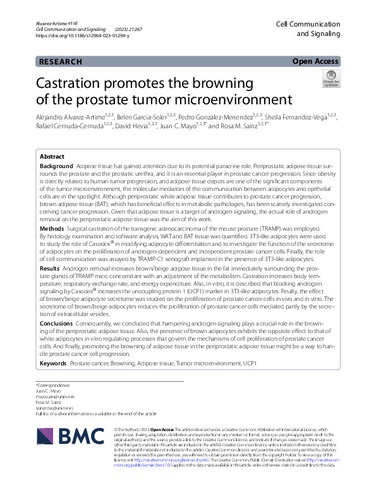Castration promotes the browning of the prostate tumor microenvironment
Editor/Coord./Trad.:
Palabra(s) clave:
Prostate cancer, Browning, Adipose tissue, Tumor microenvironment, UCP1
Fecha de publicación:
Versión del editor:
Citación:
Descripción física:
Resumen:
Background Adipose tissue has gained attention due to its potential paracrine role. Periprostatic adipose tissue surrounds the prostate and the prostatic urethra, and it is an essential player in prostate cancer progression. Since obesity is directly related to human tumor progression, and adipose tissue depots are one of the significant components of the tumor microenvironment, the molecular mediators of the communication between adipocytes and epithelial cells are in the spotlight. Although periprostatic white adipose tissue contributes to prostate cancer progression, brown adipose tissue (BAT), which has beneficial effects in metabolic pathologies, has been scarcely investigated concerning cancer progression. Given that adipose tissue is a target of androgen signaling, the actual role of androgen removal on the periprostatic adipose tissue was the aim of this work. Methods Surgical castration of the transgenic adenocarcinoma of the mouse prostate (TRAMP) was employed. By histology examination and software analysis, WAT and BAT tissue was quantified. 3T3-like adipocytes were used to study the role of Casodex® in modifying adipocyte differentiation and to investigate the function of the secretome of adipocytes on the proliferation of androgen-dependent and independent prostate cancer cells. Finally, the role of cell communication was assayed by TRAMP-C1 xenograft implanted in the presence of 3T3-like adipocytes. Results Androgen removal increases brown/beige adipose tissue in the fat immediately surrounding the prostate glands of TRAMP mice, concomitant with an adjustment of the metabolism. Castration increases body temperature, respiratory exchange rate, and energy expenditure. Also, in vitro, it is described that blocking androgen signaling by Casodex® increases the uncoupling protein 1 (UCP1) marker in 3T3-like adipocytes. Finally, the effect of brown/beige adipocyte secretome was studied on the proliferation of prostate cancer cells in vivo and in vitro. The secretome of brown/beige adipocytes reduces the proliferation of prostate cancer cells mediated partly by the secretion of extracellular vesicles. Conclusions Consequently, we concluded that hampering androgen signaling plays a crucial role in the browning of the periprostatic adipose tissue. Also, the presence of brown adipocytes exhibits the opposite effect to that of white adipocytes in vitro regulating processes that govern the mechanisms of cell proliferation of prostate cancer cells. And finally, promoting the browning of adipose tissue in the periprostatic adipose tissue might be a way to handle prostate cancer cell progression.
Background Adipose tissue has gained attention due to its potential paracrine role. Periprostatic adipose tissue surrounds the prostate and the prostatic urethra, and it is an essential player in prostate cancer progression. Since obesity is directly related to human tumor progression, and adipose tissue depots are one of the significant components of the tumor microenvironment, the molecular mediators of the communication between adipocytes and epithelial cells are in the spotlight. Although periprostatic white adipose tissue contributes to prostate cancer progression, brown adipose tissue (BAT), which has beneficial effects in metabolic pathologies, has been scarcely investigated concerning cancer progression. Given that adipose tissue is a target of androgen signaling, the actual role of androgen removal on the periprostatic adipose tissue was the aim of this work. Methods Surgical castration of the transgenic adenocarcinoma of the mouse prostate (TRAMP) was employed. By histology examination and software analysis, WAT and BAT tissue was quantified. 3T3-like adipocytes were used to study the role of Casodex® in modifying adipocyte differentiation and to investigate the function of the secretome of adipocytes on the proliferation of androgen-dependent and independent prostate cancer cells. Finally, the role of cell communication was assayed by TRAMP-C1 xenograft implanted in the presence of 3T3-like adipocytes. Results Androgen removal increases brown/beige adipose tissue in the fat immediately surrounding the prostate glands of TRAMP mice, concomitant with an adjustment of the metabolism. Castration increases body temperature, respiratory exchange rate, and energy expenditure. Also, in vitro, it is described that blocking androgen signaling by Casodex® increases the uncoupling protein 1 (UCP1) marker in 3T3-like adipocytes. Finally, the effect of brown/beige adipocyte secretome was studied on the proliferation of prostate cancer cells in vivo and in vitro. The secretome of brown/beige adipocytes reduces the proliferation of prostate cancer cells mediated partly by the secretion of extracellular vesicles. Conclusions Consequently, we concluded that hampering androgen signaling plays a crucial role in the browning of the periprostatic adipose tissue. Also, the presence of brown adipocytes exhibits the opposite effect to that of white adipocytes in vitro regulating processes that govern the mechanisms of cell proliferation of prostate cancer cells. And finally, promoting the browning of adipose tissue in the periprostatic adipose tissue might be a way to handle prostate cancer cell progression.
Colecciones
- Artículos [37543]
- Investigaciones y Documentos OpenAIRE [8372]
- Morfología y Biología Celular [175]
Ficheros en el ítem





